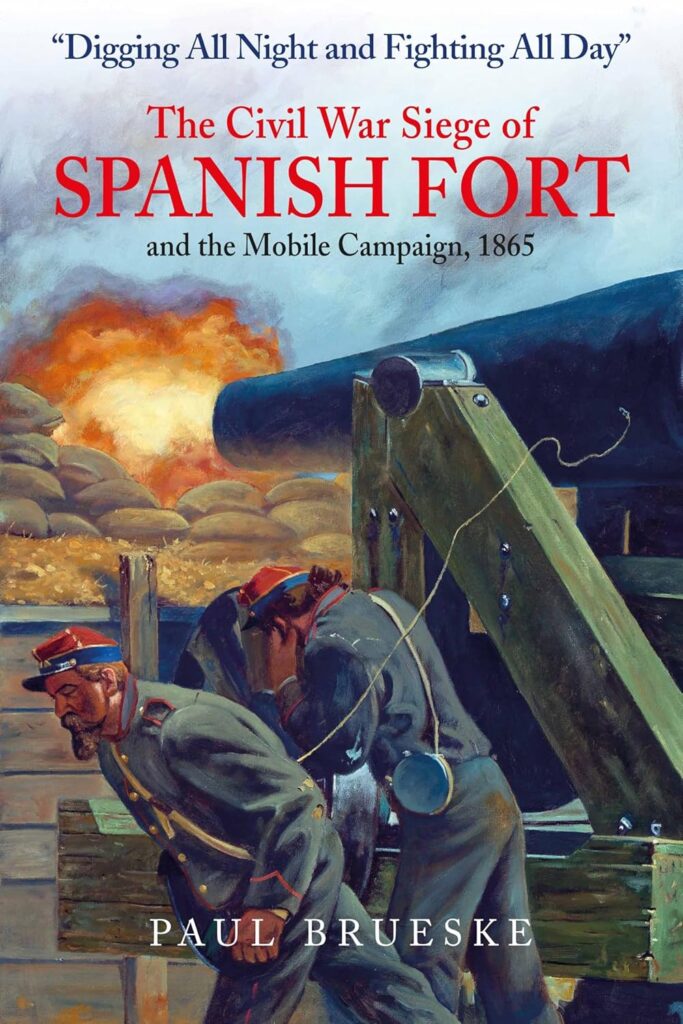Digging All Night and Fighting All Day, The Civil War Siege of Spanish Fort and the Mobile Campaign 1865




 I have a long history with the Mobile Campaign of 1864-1865. Blue and Gray has led many tours there with some of the legends of the history community including Ed Bearss, Richard McMurray and Art Bergeron to name but a few. More that 20 years ago, I was honored with a grant from the American Battlefield Protection Program to do a preservation plan and conference which is posted on the BGES Website. In preparing for the Orange Beach conference the state of awareness and preservation was fairly primitive. Scholarly analysis of the campaign was practically non existent and current historiography was woefully inadequate.
I have a long history with the Mobile Campaign of 1864-1865. Blue and Gray has led many tours there with some of the legends of the history community including Ed Bearss, Richard McMurray and Art Bergeron to name but a few. More that 20 years ago, I was honored with a grant from the American Battlefield Protection Program to do a preservation plan and conference which is posted on the BGES Website. In preparing for the Orange Beach conference the state of awareness and preservation was fairly primitive. Scholarly analysis of the campaign was practically non existent and current historiography was woefully inadequate.
Since the conference, I am happy to report that dramatic strides have been taken in practically every area and a cogent and worthy historical trail has emerged with excellent signage and a detailed campaign map which was for years printed and now is available on line. However, the most remarkable metamorphosis has taken place at Fort Blakeley and Spanish Fort where the relics of the past have been clawed back from the vegetation and made available for future generations to visit the “timeless fields and ponder what great things happened there.” Indeed the Blue and Gray Education Society will return to Mobile this year (2025) to study the campaign anew.
Digging All Night and Fighting All Day is the latest addition to the contemporary analysis of this overlooked campaign. Buried in a backwater of the larger drama unfolding around Atlanta and then in Virginia and North Carolina the importance of Mobile diminished with the closure of Mobile Bay to blockade running after the fall of Forts Morgan, Gaines and Powell in early August 1864. From that point Mobile was an apple to be plucked at the time and choosing of the victorious Federals. Leveraging their control of Pensacola Bay and their control of the land approaches from the east, the fate of the Confederate port was hardly in doubt.
Paul Brueske is a graduate student at the University of South Alabama and he serves as the head coach of the Track and Field teams. A lifelong resident of the area, he has studied the campaign for more than 20 years. This is his second book on the area. He shares his interest and expertise as the Founder and President of the Mobile Area Civil War Round Table and he is an active member of the Friends of Historic Blakeley State Park, the History Museum of Mobile and the Mobile Preservation Society. He regularly organizes and conducts tours in and around the city and the historical sites. Partnering with Fort Blakeley Director Mike Bunn, they have elevated the visibility of the campaign and experience for visitors to the area.
Brueske has produced a first rate study of a campaign that had it taken place when US Grant initially wanted it to in 1864 may have changed the complexion of the operations in the west. As it was, the alternative to operations to close Mobile and its inland shipbuilding operations, its essential rail link and its gulf access for blockade running ships was diverted to Louisiana and the attractive cotton fields along the Red River. Sherman’s relentless march to Atlanta and his subsequent turn to supply himself from the Atlantic ports in support of Grant’s determinative campaign in Virginia bypassed Mobile and relegated it to happenstance significance.
This is a shame because the military operations which were pursued showed the inner workings of both Union and Confederate strategists. General Dabney Maury hoping against hope to hold the city while awaiting relief from the heretofore potent Confederate mounted arm under Lieutenant General Nathan Bedford Forrest. A hope dashed by Forrest’s decisive defeat by General James H. Wilson’s mounted infantry arm that destroyed Forrest at Selma on April 2nd, 1865. In the meantime, Federal armies reorganized and began to move up the east side of Mobile Bay and from Pensacola in an effort to envelop the Confederate forces manning the area around Spanish Fort and Blakeley.
The Confederates had built a very credible set of works that if properly manned might have held much longer but in reality the calendar was against them. When Spanish Fort is evacuated on April 8th and Blakeley falls on April 9th the war is effectively ending with Lee’s surrender at Appomattox in Virginia.
Brueske book is an encyclopedic compendium of the relevant historiography of the campaign. His literature review is comprehensive and his analysis of its utility is fair and specific. His narrative starts slow and for a time, the first four chapters, I was worried that the book would disappoint. The switching back and forth to the different command centers was tedious and generally disruptive. This changed at Chapter 5 and for the remainder of the book it flowed well and was informative despite the switchbacks. As Brueske would introduce key players he did not leave us hanging about them but rather integrated them into the remainder of the narrative. I particularly enjoyed his treatment of Randall Gibson.
At 225 primary pages, dealing with the military operations, the book is a solid read that does not drift into the horse latitudes. His descriptions of the fortifications and the interlocking fields of fire were clearly represented so as to be obvious especially to those who have visited the sites. The limitations of the shallow waters and sand bars create the mental illusion of a well engineered fortress. Brueske takes his narrative through the surrender at Citronelle and Meridian. He then provides an exceptional summary in his epilogue. Those 17 pages are worth the price of the book by themselves—they reflect considered logic and displayed a masterful integration of what the documentation when blended with his mastery of the grounds tells us. It is indeed a battle study worthy of professional consideration.
What I particularly like about the book has become a signal feature of Savas Beatie books, the book has footnotes which allow the reader instant access to the sources used within the text. Another great feature of the book is its almanac type characteristics with 14 different, detailed and interesting appendices spread over 40 pages—the value added bang for the buck is real. Finally for the academicians among you and for the deeply curious, he has presented a 14 page exhaustive bibliography to open the various sources he uncovered in the construction of his work.
This is a wonderful work of scholarship worthy of a place on your bookshelf. If your schedule permits you should consider taking the BGES tour with Paul and Mike Bunn June 17-22, 2025.
—Len Riedel
You must be logged in to post a comment.